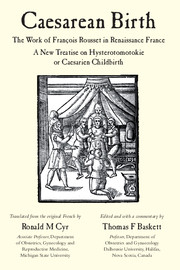 Caesarean Birth
Caesarean Birth Book contents
- Frontmatter
- Contents
- Acknowledgements
- Preface
- Translator's introduction
- François Rousset and the first text on caesarean section: a commentary by Thomas F Baskett
- A New Treatise on Hysterotomotokie or Caesarien Childbirth
- Sonnet
- Dedication
- Preface to the reader
- Part 1 Definition of caesarean childbirth
- Part 2 Second proof: logic (reason)
- Part 3 Third justification: expert opinion
- Part 4 Examples documenting other worse dangers from similar operations that are not caesarean
- Part 5 Other more popular justifications
- Part 6 On the fertility that remains after caesarean section
- A short guide to surgeons on the technique of caesarean
- Approbation
- Copyright
- Appendix 1 Summary of 16th century French history
- Appendix 2 Renée de France (1510–1575), Duchess of Ferrara, Chartres, Montargis and Nemours
- Appendix 3 Jacques de Savoie-Nemours (1531–1585), Duc de Nemours and Genevois
- Index
Part 2 - Second proof: logic (reason)
Published online by Cambridge University Press: 05 June 2014
- Frontmatter
- Contents
- Acknowledgements
- Preface
- Translator's introduction
- François Rousset and the first text on caesarean section: a commentary by Thomas F Baskett
- A New Treatise on Hysterotomotokie or Caesarien Childbirth
- Sonnet
- Dedication
- Preface to the reader
- Part 1 Definition of caesarean childbirth
- Part 2 Second proof: logic (reason)
- Part 3 Third justification: expert opinion
- Part 4 Examples documenting other worse dangers from similar operations that are not caesarean
- Part 5 Other more popular justifications
- Part 6 On the fertility that remains after caesarean section
- A short guide to surgeons on the technique of caesarean
- Approbation
- Copyright
- Appendix 1 Summary of 16th century French history
- Appendix 2 Renée de France (1510–1575), Duchess of Ferrara, Chartres, Montargis and Nemours
- Appendix 3 Jacques de Savoie-Nemours (1531–1585), Duc de Nemours and Genevois
- Index
Summary
After this first proof by case histories comes the second, by logical argument; this considers the nature or substance of the subject, examined systematically for each of the three parts that must be incised in order to deliver the child. These are:
The muscles of the anterior abdominal wall, called epigastric in Greek and abdominal in Latin.
The peritoneum, which is the membrane of the abdomen, found below the muscles described above.
The uterine body. As far as the bladder is concerned, although it lies naturally between the peritoneum and the uterus, it does not present at the site of the caesarean incision – being caudal to the hypogastrium, particularly in women about to deliver, in whom the distended uterus pushes it downward. Especially during labour, at which time it is almost always empty as a result of the urinary frequency experienced by these women; it is consequently even further away from the site of the incision.
The muscles of the abdominal wall
The first part to incise; size of the incision
In the first place, it seems that these muscles can be incised without any danger of death – if only because Galen describes in his ‘Method’ how to suture the wound by careful gastrorrhaphy.
It may be objected that the size of the incision poses an obvious danger; the same author demonstrates that an incision of this size is not dangerous, advising that such abdominal wounds be enlarged if they appear too small to allow reduction of any bowel or omentum that might have protruded through the incision.
- Type
- Chapter
- Information
- Caesarean BirthThe Work of François Rousset in Renaissance France - A New Treatise on Hysterotomotokie or Caesarian Childbirth, pp. 42 - 48Publisher: Cambridge University PressPrint publication year: 2010


